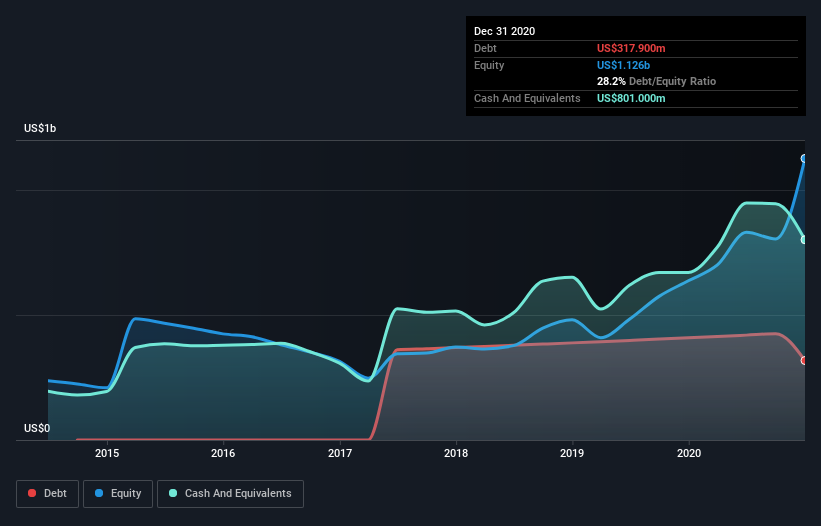Is Neurocrine Biosciences (NASDAQ:NBIX) Using Too Much Debt?
Legendary fund manager Li Lu (who Charlie Munger backed) once said, 'The biggest investment risk is not the volatility of prices, but whether you will suffer a permanent loss of capital.' It's only natural to consider a company's balance sheet when you examine how risky it is, since debt is often involved when a business collapses. We can see that Neurocrine Biosciences, Inc. (NASDAQ:NBIX) does use debt in its business. But the real question is whether this debt is making the company risky.
When Is Debt A Problem?
Generally speaking, debt only becomes a real problem when a company can't easily pay it off, either by raising capital or with its own cash flow. If things get really bad, the lenders can take control of the business. However, a more usual (but still expensive) situation is where a company must dilute shareholders at a cheap share price simply to get debt under control. Of course, the upside of debt is that it often represents cheap capital, especially when it replaces dilution in a company with the ability to reinvest at high rates of return. When we think about a company's use of debt, we first look at cash and debt together.
View our latest analysis for Neurocrine Biosciences
What Is Neurocrine Biosciences's Net Debt?
You can click the graphic below for the historical numbers, but it shows that Neurocrine Biosciences had US$317.9m of debt in December 2020, down from US$408.8m, one year before. But it also has US$801.0m in cash to offset that, meaning it has US$483.1m net cash.
A Look At Neurocrine Biosciences' Liabilities
According to the last reported balance sheet, Neurocrine Biosciences had liabilities of US$186.5m due within 12 months, and liabilities of US$422.0m due beyond 12 months. On the other hand, it had cash of US$801.0m and US$157.1m worth of receivables due within a year. So it can boast US$349.6m more liquid assets than total liabilities.
This short term liquidity is a sign that Neurocrine Biosciences could probably pay off its debt with ease, as its balance sheet is far from stretched. Succinctly put, Neurocrine Biosciences boasts net cash, so it's fair to say it does not have a heavy debt load!
In addition to that, we're happy to report that Neurocrine Biosciences has boosted its EBIT by 44%, thus reducing the spectre of future debt repayments. The balance sheet is clearly the area to focus on when you are analysing debt. But ultimately the future profitability of the business will decide if Neurocrine Biosciences can strengthen its balance sheet over time. So if you want to see what the professionals think, you might find this free report on analyst profit forecasts to be interesting.
But our final consideration is also important, because a company cannot pay debt with paper profits; it needs cold hard cash. While Neurocrine Biosciences has net cash on its balance sheet, it's still worth taking a look at its ability to convert earnings before interest and tax (EBIT) to free cash flow, to help us understand how quickly it is building (or eroding) that cash balance. Over the most recent three years, Neurocrine Biosciences recorded free cash flow worth 72% of its EBIT, which is around normal, given free cash flow excludes interest and tax. This free cash flow puts the company in a good position to pay down debt, when appropriate.
Summing up
While we empathize with investors who find debt concerning, you should keep in mind that Neurocrine Biosciences has net cash of US$483.1m, as well as more liquid assets than liabilities. And it impressed us with its EBIT growth of 44% over the last year. So is Neurocrine Biosciences's debt a risk? It doesn't seem so to us. The balance sheet is clearly the area to focus on when you are analysing debt. But ultimately, every company can contain risks that exist outside of the balance sheet. Case in point: We've spotted 2 warning signs for Neurocrine Biosciences you should be aware of, and 1 of them doesn't sit too well with us.
At the end of the day, it's often better to focus on companies that are free from net debt. You can access our special list of such companies (all with a track record of profit growth). It's free.
This article by Simply Wall St is general in nature. It does not constitute a recommendation to buy or sell any stock, and does not take account of your objectives, or your financial situation. We aim to bring you long-term focused analysis driven by fundamental data. Note that our analysis may not factor in the latest price-sensitive company announcements or qualitative material. Simply Wall St has no position in any stocks mentioned.
Have feedback on this article? Concerned about the content? Get in touch with us directly. Alternatively, email editorial-team (at) simplywallst.com.

 Yahoo Finance
Yahoo Finance 
